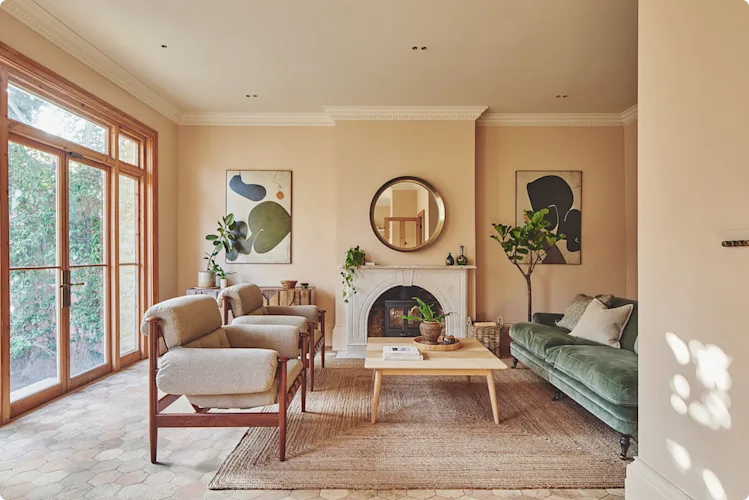© Topology Project
Some design trends are fleeting while others stand the test of time. But a commonality among them is that the more popular the trend, the more expensive they generally tend to be. We run through some of the best cost-saving alternatives to your favourite trends.
Crittall window and door frames
Crittall windows were created by an ironmonger called Francis Henry Crittall in 1860. This distinctive style of window and door frame is associated with the art deco and modernist architectural moments in the 1920s and ‘30s. But their popularity still reigns today and plenty of newly renovated residential buildings like refurbished old factories have them to meet a certain aesthetic.
They’re distinctive for their black metal frames, sleek lines and multiple glass rectangles. But recurring challenges for people who enjoy the style is the cost of both the materials and having them installed. Real, original Crittall windows and frames are usually trademarked – this often means there’s a long waiting list to get hold of them and they can be very expensive. They’re also traditionally made of steel but aluminium makes a great, cost-saving alternative, looks just as sleek and doesn’t come with a queue around the block.
Another way to create a Crittall effect in your own home is to invest in wooden framed windows or doors in the modern rectangular pattern and carefully paint them with a matt black paint to create a similar visual effect. This non-drip matt paint from Wickes can be used on wood and metal – perfect for touch-ups (which, if you’re opting for external Crittall-effect windows will be often as the elements will require the frames to be sanded and refinished often to maintain a fresh look). Unless you’re highly in the know, you’re unlikely to bat an eyelid besides appreciating the outward appearance.

© Veronica Rodriguez
Be guided by the experts
If you’re looking to refresh your home but you’re not sure where to start, interior designers may just be the expert eye that you need. Whether you have an unusual layout that you’d like to navigate with a clear design vision, you’re short on time and need a steer on timelines or you just could use a helping hand to bring your big ideas to life, finding an interior designer that understands your mission could save you money overall.
 © Topology Project
© Topology Project
We spoke to London-based, self-professed ‘affordable designers’ Topology Interiors about cost-saving alternatives to popular design trends. Their ethos is to create affordable, friendly and sophisticated interiors for real-life homes. Read on for Interior Designer, Chloe Weller's top tips for saving money on your interior design.
Can you give some examples of cost saving alternatives to popular design trends?
There are many cost-saving alternatives that capture the essence of the trend you love while being mindful of your budget. With a bit of creativity and resourcefulness, you can achieve a stylish and on-trend look without overspending. Here are some examples of how you can stay on trend within your budget:
- Furniture: You don't have to furnish your entire home with expensive pieces. Mix statement higher-end pieces with more affordable options to create a balanced and budget-friendly interior. Splurge on key pieces that will make a significant impact, while opting for lower-priced alternatives for less focal areas.
- Shop vintage: Shopping second hand for your home is also a great way to save money, allowing you to find unique pieces at a fraction of their original cost, while also promoting sustainability by giving pre-loved items a new life.
- Marble: Instead of using a natural marble, consider using lower-cost marble-patterned or faux marble finishes. These can be found in various materials such as laminate, porcelain tile, or even vinyl flooring. They offer a similar aesthetic at a fraction of the cost.
- Open Shelving: Open shelving has grown in popularity, but custom-built shelving can be expensive. Instead, opt for affordable off the shelf floating shelves that you or a handy person can easily fit to the wall.
- Upholstery: High-end designer fabrics can be expensive when used for upholstery or window treatments. Look for budget-friendly fabrics with similar patterns or colours to achieve a comparable look. Many affordable fabric stores offer a wide range of options that can fit your design vision.
- Built-in Storage: Custom built-in storage solutions can be quite expensive. Opt for modular storage units or freestanding furniture pieces with ample storage options instead. They can be rearranged and repurposed as your needs change, and they are often more affordable compared to built-in alternatives.
- Tiles: Instead of covering an entire wall or floor with expensive tiles, consider using them sparingly as a border or focal point around the shower or bath area. This way, you can achieve a similar impact while using fewer tiles, reducing both material and installation costs.
- Artwork and wall decor: Original artwork can be costly, but there are budget-friendly alternatives available. Look for affordable prints, posters, or even create your own artwork using paint, or even framing fabric patterns, wallpaper samples, or vintage postcards for unique and inexpensive wall decor.

 ©
© 



